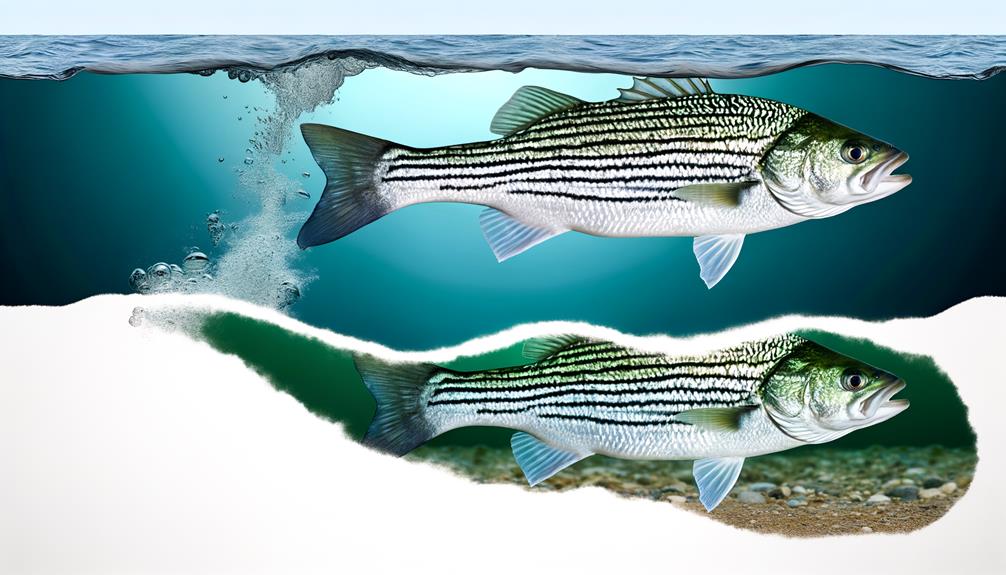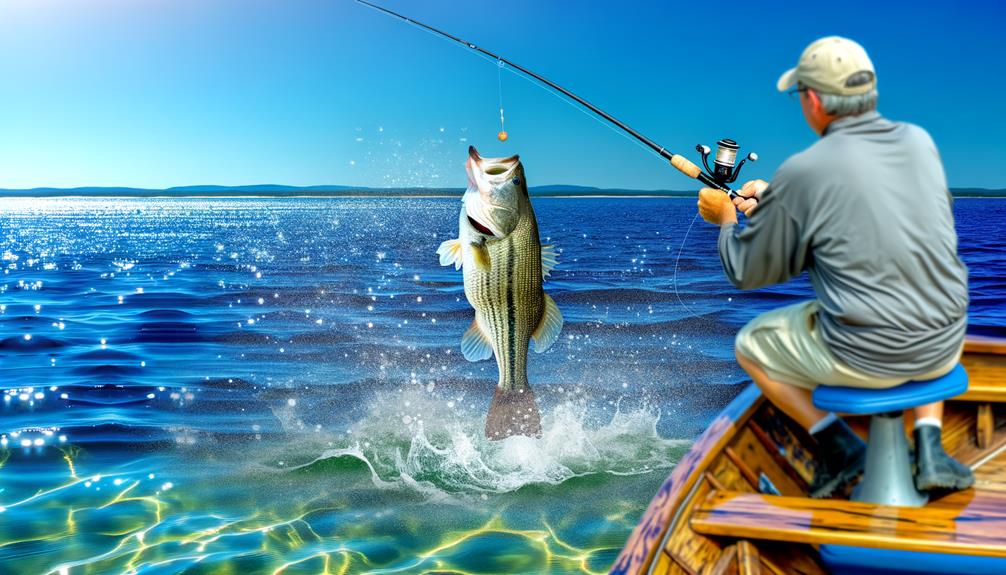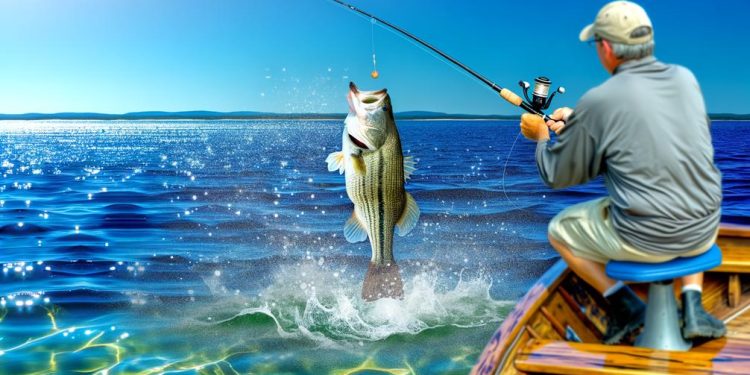Are Striped Bass Saltwater Fish
The classification of Striped Bass, or Stripers as they are colloquially known, as saltwater fish is a topic of ongoing debate among marine biologists and fishing enthusiasts.
While their primary habitat is the Atlantic coast, these fish are known for their adaptability, thriving in both freshwater and saltwater environments.
This raises the intriguing question: should we categorize these fascinating creatures as saltwater species, or do their freshwater adaptations suggest a more complex classification?
The answer could have significant implications for our understanding of this species and their conservation.
Key Takeaways
- Striped Bass are primarily saltwater fish, prevalent along the Atlantic coast from Florida to Canada.
- They exhibit anadromous behavior, spawning in freshwater but mainly residing in saltwater environments.
- Striped Bass can adapt to freshwater habitats, with landlocked populations formed during dam constructions.
- Despite their saltwater origin, Striped Bass are also stocked in freshwater for recreational fishing.
Understanding Striped Bass Habitat
In order to gain a comprehensive understanding of the striped bass species, it is crucial to explore their unique habitat, which encompasses both saltwater and freshwater environments. Striped bass are primarily saltwater fish but display an adaptive flexibility, enabling them to thrive in both marine and freshwater ecosystems. This trait is an example of their anadromous nature, a term defining species that spawn in freshwater rivers, but spend the majority of their adult lives in saltwater.
The geographical distribution of striped bass is extensive, ranging along the Atlantic coastline of North America, from Florida to Canada. Their preferred habitats in saltwater include coastal areas, bays, and estuaries; areas abundant with food sources and optimal for migration.
The intricate connection between the striped bass and its dual habitat is paramount to understanding their survival and propagation strategies. This understanding supports effective conservation and management efforts, ensuring the continued existence of this significant anadromous fish. Recognizing the complexities of their habitat utilization not only enhances our knowledge of the striped bass but also fosters a deeper appreciation for the intricate interplay of marine and freshwater ecosystems.
Characteristics of Saltwater Striped Bass
The unique characteristics of saltwater striped bass exemplify their adaptability and resilience in marine environments, particularly along the Atlantic and Pacific coasts. Their specific traits have enabled them to thrive in a variety of conditions, demonstrating their enduring presence in their habitat.
These characteristics include:
- Predominant occurrence along the Atlantic Coast, particularly north of South Carolina, indicating their preference for temperate saltwater environments.
- Anadromous nature, characterized by their migration into freshwater rivers for spawning, showcasing their adaptability.
- Presence along the Pacific Coast, spanning from Canada to Mexico, signifying their broad geographical range.
- An average size ranging from 20 to 35 inches, with some individuals exceeding 70 pounds, highlighting their capacity for significant growth in saltwater environments.
- Behavioral differences from freshwater striped bass, such as feeding and migration patterns, which have evolved due to their specific saltwater habitat.
In essence, saltwater striped bass are a testament to the diversity and adaptability of marine life. Their characteristics not only reflect their resilience but also their intricate relationship with their habitat, making them an integral part of the marine ecosystem.
Freshwater Striped Bass Explained

While saltwater striped bass are predominantly marine creatures, their freshwater counterparts, often stocked from Atlantic populations into inland lakes and rivers for recreational fishing, exemplify an equally significant adaptability and diversity. Freshwater striped bass are not just biological marvels, but they also serve as popular game fish for recreational fishing enthusiasts.
One of the significant aspects of freshwater striped bass is their genetic malleability, often hybridized with white bass to produce versatile ‘wiper’ fish. These hybrid striped bass mirror their parent species in appearance yet are typically smaller, making them suitable for freshwater environments.
Historical records indicate the occurrence of freshwater striped bass in landlocked populations, primarily during dam constructions. One such example is the Coosa River, where dam constructions have inadvertently led to the formation of freshwater striped bass populations.
In terms of size, freshwater striped bass can reach considerable dimensions. The record size for freshwater striped bass exceeds 70 pounds, highlighting their impressive adaptability to freshwater habitats. This adaptability further underscores the biological resilience of striped bass, whether in saltwater or freshwater conditions.
Comparing Saltwater and Freshwater Bass
Examining both saltwater and freshwater striped bass reveals intriguing differences and similarities, particularly in terms of their habitats, sizes, and prevalence.
- Saltwater striped bass make their home along the Atlantic coast, with a high concentration found north of South Carolina. They typically grow larger than their freshwater counterparts.
- Freshwater striped bass, on the other hand, are stocked from Atlantic populations and thrive in inland lakes and rivers across the country.
- A fascinating cross between the two, the hybrid striped bass, combines elements of both and is stocked in freshwater areas nationwide.
- Despite the usual size difference, freshwater striped bass can still reach sizes comparable to saltwater bass, dispelling the myth that they are always significantly smaller.
- Interestingly, landlocked striped bass have been discovered during dam constructions, and successful reproduction has been observed in certain rivers, indicating a remarkable adaptability to freshwater environments.
These observations provide a nuanced understanding of the adaptability of striped bass, challenging conventional perceptions and deepening our appreciation for the resilience and versatility of this species.
Whether in saltwater or freshwater, striped bass continue to intrigue and captivate, proving their worth as a beloved fish among enthusiasts.
Fishing Techniques for Striped Bass

Understanding the most effective fishing techniques for striped bass can significantly enhance an angler’s success, whether fishing in saltwater or freshwater environments.
In saltwater, trolling with deep diving lures or umbrella rigs is proven effective. These techniques allow for coverage of a vast area, increasing the odds of attracting a striped bass. Additionally, drifting live bait such as eels, menhaden, or squid is a highly efficacious method in coastal waters. These baits mimic the natural food sources of striped bass, triggering their predatory instincts.
On the other hand, jigging with heavy jigs near structure or drop-offs is a popular technique that exploits the bass’s natural inclination to stay close to underwater structures for protection and feeding.
Moreover, casting topwater plugs or swimbaits along shorelines or rocky areas can entice aggressive striped bass to strike, capitalizing on their territorial behaviour.
Lastly, using surfcasting gear with cut bait like bunker or mullet can yield success. This method is particularly effective when fishing for striped bass from beaches or jetties, harnessing the migration patterns of these saltwater fish.
Frequently Asked Questions
Are Striped Bass Freshwater and Saltwater?
Striped bass exhibit an intriguing behavioural pattern known as bass migration. They inhabit both freshwater and saltwater environments, adeptly adapting their striped bass habitat for reproduction and survival, showcasing nature’s remarkable resilience and adaptability.
Are Saltwater Striped Bass Good to Eat?
Yes, saltwater striped bass are good to eat, renowned for their mild, sweet flavor. However, due to potential mercury content, consumption should be limited. Proper cooking, particularly grilling, can enhance their taste and texture.
Are Bass Freshwater or Saltwater?
Striped bass exhibit remarkable adaptability, inhabiting both freshwater and saltwater environments. Predominantly, they thrive in saltwater, showcasing unique behavior like migration for spawning. Hence, bass habitat straddles both fresh and marine waters, illustrating their versatile nature.
Are Striped Bass in the River or the Ocean?
Striped bass inhabit both river and ocean environments due to their anadromous nature. Their migration patterns involve spawning in freshwater rivers in spring, then returning to the Atlantic coast’s saltwater habitats for the remainder of the year.
Conclusion
In conclusion, striped bass, with their distinctive markings and impressive size, are unique in their ability to inhabit both saltwater and freshwater environments.
The subtle variations between the two populations offer intriguing insights into their adaptability and survival strategies. Understanding these differences and mastering the appropriate fishing techniques can enhance the angler’s experience and success in pursuing this versatile species.
The striped bass stands as a testament to nature’s adaptability and the remarkable diversity within aquatic ecosystems.



